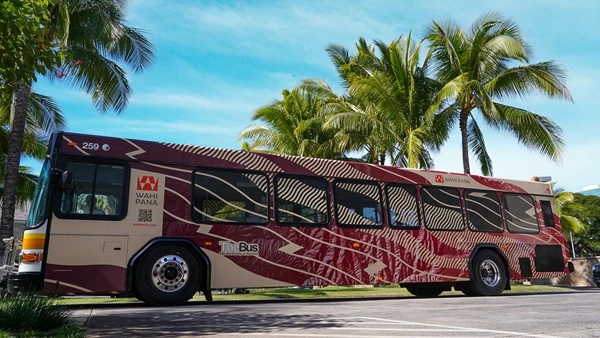What does it cost to run Honolulu’s buses?
The City and County of Honolulu’s Department of Transportation Service 2025 fiscal year budget was a little over $438 million. Of that, O‘ahu Transit Services, Inc., the nonprofit contractor that manages TheBus and TheHandi-Van, took the lion’s share, taking $325.9 million. A proposed budget for the 2025-2026 fiscal year would increase the OTS budget to $341 million.
But where does that money go?
O‘ahu Transit Services lists a fleet size of 542 buses, with an average age of nearly 10 years, along with an additional 180 Handi-Vans.
According to OTS budget documents, the greatest single expenditure in the bus and paratransit budget during the 2025-2026 fiscal year was salaries and wages. Employee pay is projected to cost $168.6 million between July 2025 and June 2026.
OTS states on its website that it employs a total of 1,919 employees. Of those, 1,211 are drivers — 901 bus drivers and 310 Handi-Van drivers.
Other employees include 358 maintenance staff — the majority of which are bus maintenance — 251 support staff and 109 administrative jobs.
This would average out to, very roughly, yearly wages of $87,800 per employee, although pay varies wildly between positions. A job listing for a paratransit operator — a driver of a vehicle specialized for handicapped passengers — sets wages at $21 per hour, while another listing for a paratransit mechanic offers a hiring rate of $30 per hour.
Beyond wages, another $167 million out of OTS’ projected budget this year will cover the wide-ranging expenses of maintaining a fleet of vehicles. For example, diesel fuel is expected to cost about $19 million by the end of the fiscal year, and unleaded gasoline another $4 million.
Other major expenses include:
• Bus parts, $16 million this year
• Retirement plans for union workers: $23.9 million
• Healthcare plans for union workers: $37.5 million
• Trust fund contributions: $23.5 million
• Materials and supplies: $5 million
• Security services: $1.6 million
• Electricity costs: $2.1 million
• Firefighting equipment: $265,000
But how does that budget square up against other bus systems nationwide?
The American Public Transportation Association — a nonprofit industry advocate group for public transportation organizations throughout the country — ranked Honolulu’s transit system among the 50 largest in the U.S. in 2023. That year, it found that TheBus passengers had collectively traveled 182 million miles, comparable to the Maryland Transit Administration (183.6 million miles) or Las Vegas’ Regional Transportation Commission of Southern Nevada (183.4 million miles).
The MTA’s operating budget for the 2024 fiscal year allocated about $450 million to bus operations. Its cost per passenger mile for that year was $2.46.
Data from the U.S. Department of Transportation found that OTS spent $1.30 per passenger mile in 2024. Transit systems with a similar cost per passenger mile include the University of California Davis’ Unitrans bus system, which had a roughly $8.4 million operating budget in 2024; the Nassau Inter-County Express in New York (2024 operating budget: $131 million) and the Flint, Mich., Mass Transit Authority (2024 operating budget: $17 million).
The U.S. DOT data also found the OTS system spends $5.96 per passenger trip and spent $173.70 per hour.
Meanwhile, OTS generated about $45 million in fares last year, compared to a $245 million operating budget. DTS Director Roger Morton previously told ASD that only about $11 million of that comes from cash users.
Based on the 2020 Honolulu census, which set the population at 853,000, APTA determined the city’s ridership per capita — in other words, the average number of annual bus rides taken per person — to be 45.9, the 10th highest in the nation. The next-highest, the Seattle-Tacoma transit system, has a 41.8 ridership per capita, while the New York-New Jersey-Newark system — with the highest ridership per capita — sits at 163.5.
However, TheBus ridership seems to be declining. OTS reported in June that average ridership that month had dropped by 2% from the same month in 2024, while ridership is about 33% below pre-pandemic level: the total monthly ridership in January was 3.4 million, while in January 2020 monthly ridership was 4.9 million, which itself was a decline from January 2019.
Aloha State Daily reached out to APTA for comment.
For the latest news of Hawai‘i, sign up here for our free Daily Edition newsletter.





